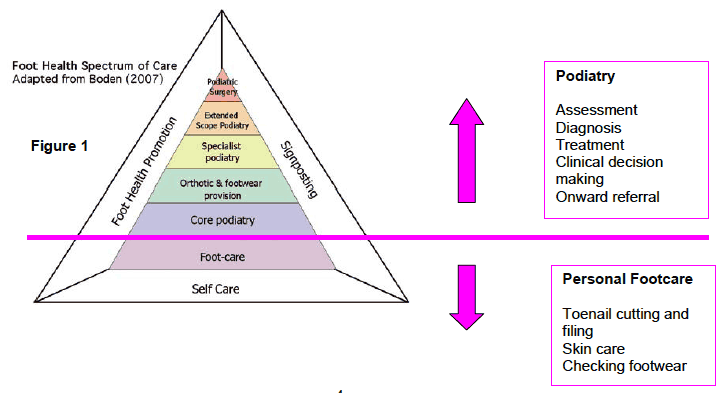Personal Footcare Guidance
The overall aim of the personal footcare guidance is to improve the way in which personal footcare is supported and delivered through the implementation of good practice guidance.
2: Understanding Personal Footcare
The challenge publicly funded services face is to make sure they deliver safe, effective and person centred care. This is underpinned by best value, supporting empowerment and enablement for people where this is appropriate.
What is Personal Footcare?
The Scottish definition for personal footcare agreed by the national working group has been adapted from the version proposed by the Department of Health.[1]
Personal footcare is part of a personal hygiene routine for feet and covers a set of tasks that an adult, whatever their age, would normally do for themselves if they are able to. The specific tasks are detailed in Table 1 below;
| Toenail care |
Clipping and filing toenails safely and keeping them at a length which feels comfortable |
|---|---|
| Skin care |
Smoothing and moisturising dry and rough skin Keeping feet clean, dry, comfortable and warm Checking for cracks and breaks in the skin Looking for signs of infection or other obvious early problems and seeking professional advice |
| Checking footwear |
Checking footwear for comfort, fit, state of repair and safety |
The broad function of podiatry services is documented by the Society of Chiropodists and Podiatrists as illustrated at Figure 1.[2], [3]
Figure 1

NHS Podiatry Service Provision
NHS podiatry services in Scotland target public resources appropriately to meet the increasing demands and needs of people with a clinical or medical need for podiatry care. Through utilising a competent and skilled workforce and providing seamless care in core and specialist practice, NHS Podiatry can provide a safe, effective and person centred service that includes:
- Supporting, helping and encouraging individuals and their carers to self care where this is possible
- Providing education to non podiatry providers across all care sectors to help them to confidently undertake personal footcare for those individuals who require support with this
- Undertaking individual assessment and diagnosis of conditions of the lower limb and foot; and subsequently providing education and clinical treatment supported by sound clinical decision making skills.
- Providing a comprehensive foot health service for conditions affecting the foot and lower limb. The early involvement of podiatrists can prevent future lower limb and foot problems
- Working in partnership with individuals and other health care professionals to provide a variety of therapies and services which may be used to achieve pain relief and avoid potential problems, for example by the use of insoles, nail surgery or podiatric surgery
In Scotland, NHS podiatry managers have agreed that the provision of personal footcare does not require the specialist skills of a podiatrist. However they are committed to working in partnership with key stakeholders to promote the resources published alongside this document for users and carers, and to supporting the development of local footcare approaches which support those no longer able to undertake self care and signposting them towards what is available.
Contact
Email: Julie Townsend
There is a problem
Thanks for your feedback